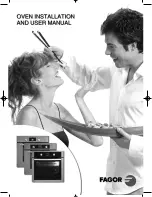
IMPORTANT SAFETY INSTRUCTIONS
Due to the high temperatures radiated, objects left near the oven
could catch fire. Do not use the oven to heat up the room.
Oils and fats are a fire hazard if allowed to overheat. Never leave
the oven unattended when cooking with oil or fats. Never attempt to
put out oil or fat fires with water. Turn the oven off and extinguish the
flames by leaving the door closed.
Broiling food for excessively long cooking durations can cause it
to dry out with the risk of catching fire. Do not exceed the
recommended cooking durations.
Some foods dry out very quickly and can be ignited by high
broiling temperatures. Do not use broiling modes for crisping rolls or
bread, or to dry flowers or herbs. Instead use the Convection Bake/
Convection Roast
or Surround
modes.
If using alcohol in your recipes, please be aware that high
temperatures can cause the alcohol to evaporate. The vapor can
catch fire on hot heating elements.
When using residual heat to keep food warm, corrosion from high air
humidity and condensation can occur in the oven. This can cause
damage to the control panel, countertop, and cabinet carcase. Keep
the oven on and select the lowest temperature available for the selected
operating mode. The cooling fan will then continue to run automatically.
Food which is stored in the oven compartment or left in it to be
kept warm can dry out and the moisture released can lead to
corrosion damage in the oven. Always cover food that is left in the
oven to keep warm.
A buildup of heat can cause the enamel on the floor of the oven to
crack or flake off.
Never line the floor of the oven with aluminum foil or oven liners.
If you wish to place dishware on the floor of the oven during the
cooking process, or place dishware on the floor of the oven to heat it
up, you can do so, but only with the Convection Bake/Convection
Roast
operating mode, without the Booster function.
13














































